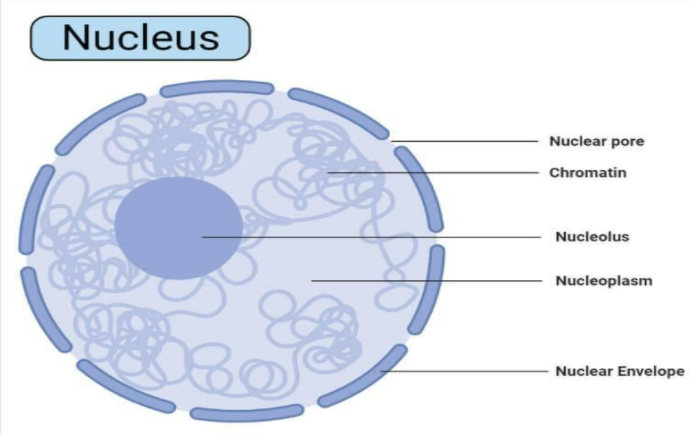
Why is the nucleus called the brain of the cell?
Answer
397.5k+ views
1 likes
Hint: A cell is a structural and functional unit of life. And it is the smallest structural (microscopic) unit of living matter and makes up all living things.
Complete answer:
In eukaryotic cells, the nucleus is an organelle. The majority of the cell's genetic material is contained within its totally encased nuclear membrane. Chromosomes are formed from this material, which is structured as DNA molecules and a variety of proteins.
The nucleus of a cell is located in the middle of the cytoplasm, which is the liquid that fills the cell. The nucleus, on the other hand, may not be located at the centre of the cell. The nucleus, which takes up roughly 10% of the cell's volume, is normally found in the cell's centre.
The component of a nucleus contains the cell's DNA which controls the ribosome and protein production.
The nucleus directs and regulates the cell's functions (such as development and metabolism) and houses the genes, which hold the cell's genetic information.
Hence, due to these functions of a nucleus it is called the brain of the cell.
Note:
A cell is made up of three parts that are the cell membrane, the nucleus, and the cytoplasm, which sits between these two parts. The cytoplasm contains elaborate arrangements of fine fibres as well as hundreds, if not thousands, of tiny yet unique structures known as organelles. They support the body's structure, absorb nutrients from meals, transform those nutrients to energy, and perform specialised functions. Cells also contain the body's genetic material and have the ability to replicate them.
Image of a Nucleus is as follows:

Complete answer:
In eukaryotic cells, the nucleus is an organelle. The majority of the cell's genetic material is contained within its totally encased nuclear membrane. Chromosomes are formed from this material, which is structured as DNA molecules and a variety of proteins.
The nucleus of a cell is located in the middle of the cytoplasm, which is the liquid that fills the cell. The nucleus, on the other hand, may not be located at the centre of the cell. The nucleus, which takes up roughly 10% of the cell's volume, is normally found in the cell's centre.
The component of a nucleus contains the cell's DNA which controls the ribosome and protein production.
The nucleus directs and regulates the cell's functions (such as development and metabolism) and houses the genes, which hold the cell's genetic information.
Hence, due to these functions of a nucleus it is called the brain of the cell.
Note:
A cell is made up of three parts that are the cell membrane, the nucleus, and the cytoplasm, which sits between these two parts. The cytoplasm contains elaborate arrangements of fine fibres as well as hundreds, if not thousands, of tiny yet unique structures known as organelles. They support the body's structure, absorb nutrients from meals, transform those nutrients to energy, and perform specialised functions. Cells also contain the body's genetic material and have the ability to replicate them.
Image of a Nucleus is as follows:

Latest Vedantu courses for you
Grade 11 Science PCM | CBSE | SCHOOL | English
CBSE (2025-26)
School Full course for CBSE students
₹41,848 per year
Recently Updated Pages
Express the following as a fraction and simplify a class 7 maths CBSE

The length and width of a rectangle are in ratio of class 7 maths CBSE

The ratio of the income to the expenditure of a family class 7 maths CBSE

How do you write 025 million in scientific notatio class 7 maths CBSE

How do you convert 295 meters per second to kilometers class 7 maths CBSE

Write the following in Roman numerals 25819 class 7 maths CBSE

Trending doubts
State and prove Bernoullis theorem class 11 physics CBSE

What are Quantum numbers Explain the quantum number class 11 chemistry CBSE

Write the differences between monocot plants and dicot class 11 biology CBSE

Who built the Grand Trunk Road AChandragupta Maurya class 11 social science CBSE

1 ton equals to A 100 kg B 1000 kg C 10 kg D 10000 class 11 physics CBSE

State the laws of reflection of light




